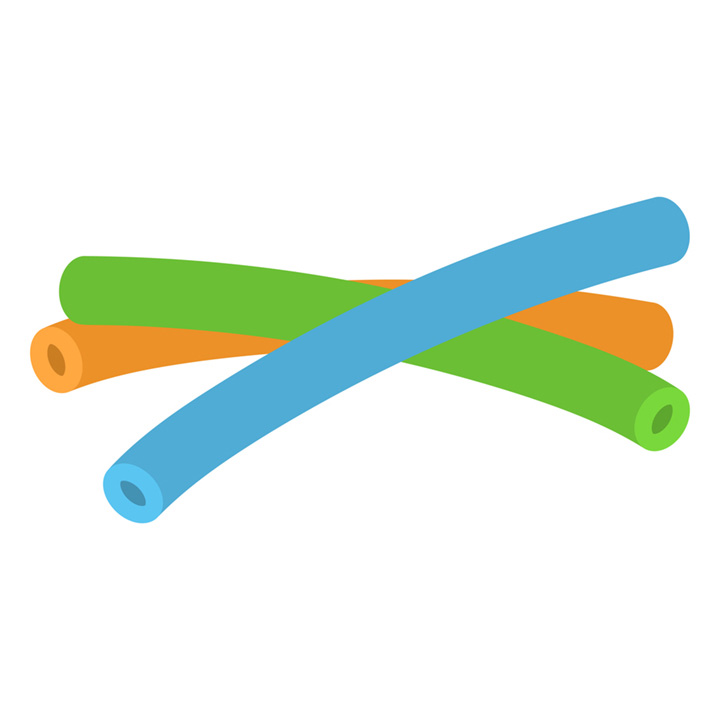
What was the most important thing you’ve learned this year?
To end the school year, a Grade 3 teacher wanted learners to reflect on their learning for the entire year in a creative and thoughtful way that would celebrate the collaborative competencies that they had honed as classmates.
The teacher placed a large black garbage bag full of pool noodle pieces on the carpet and asked learners to make predictions about what they thought might be in the bag. Learners weren’t allowed to touch it. They then did a “turn-and-talk” with the person beside them to come up with at least three ideas of what they thought might be in the bag. They shared their ideas, and the teacher recorded them on the board. The predictions that the learners made were very interesting and diverse, but nobody came up with the correct answer, so the teacher gave them one clue to help them figure it out. The clue was, “The items in the bag are of a variety of shapes and colours.”
The learners participated in another turn-and-talk and discussed what their new ideas might be. They then shared their new ideas and compared them to what the original ideas were now that they had more information. Learners shared ideas, and the teacher crossed off the predictions that did not meet the criteria anymore, and the new ideas were written on the board. Two groups of learners were able to predict the correct answer—“pool noodles.” The teacher then opened the bag of pool noodle pieces and placed them on the carpet alongside a large box of toothpicks. Learners were asked to take 20 pieces (or fewer) of pool noodles and a small handful of toothpicks. They were then asked to go back to their tables and create one object together with their group members. The only criteria they had was that it had to be a compromise of ideas of all group members, and they had five minutes to create it. After building, learner teams placed their finished creations at the front of the room where they offered their ideas on what they thought other learners had made. The teacher then asked the learners to take their creations back to their tables where they were asked to write about how they made their object, how their group collaborated, or what they wished they could have created.
On the second day, the teacher asked the guiding question, “What were some of the most important ideas that you have learned this year?” This question was to help learners reflect on what they felt was some of the most important learning they had engaged in throughout the school year. They were asked to do a turn-and-talk and discuss at least five different ideas that they could then share with the whole class. Learners collaborated in groups of three, and each learner was asked to think of at least two or three ideas that they felt were the most important and why. They then shared their ideas with their group members and explained why they felt it was one of the most important things they learned during the year. The group was then asked to critically think and compromise, and to be ready to share their top five responses.
Groups then shared their top five ideas, and the teacher recorded their responses on the board. Tally marks were used when groups shared similar ideas. The teacher then led a discussion about what they noticed about their ideas and asked the learners to do another turn-and-talk and have a conversation about what was surprising, what ideas they wished they had thought of, and what potential new ideas could be added. They then shared one thing with the class that they wanted the other learners to know about their conversation.
Learners were then tasked with creating something that represented one important idea that all members could agree on making. Learners could use as many pool noodle pieces and toothpicks as they wanted for this joint task. The teacher then created criteria together with her learners about what they would need to remember so that every group member felt successful during their collaborative work together. Learners shared their ideas, and the task, intent, and criteria were written on the board to help them be successful. They were given 45 minutes to sketch and label their initial ideas in their sketchbooks. Learners then began the process of building their ideas. After 30 minutes, the teacher brought them back to the carpet to discuss the importance of receiving feedback.
Learners were then paired with another group to share their beginning projects and were asked to give feedback on their beginning sketch, as well as the construction or what might be added or changed to improve it. They then finished their building using the feedback they were given by their peers. Learners placed their finished creations at the front of the room and shared what they created and why, their reflections on working with their group members, and what they might do differently next time when working with a group, based on what the other members had shared. Examples of some of the pool noodle creations that groups shared, which represented learning from their Grade 3 year, included the province of Manitoba, trees/plants, and two people holding hands to represent friendship.
Pool noodles were cut into a variety of shapes and sizes to make it easier for learners to build their creations. These materials could be used for any curricular area and can be taken apart after and re-used many times.